Vimeo Bundle
Who Really Owns Vimeo?
Understanding the ownership structure of a company is crucial for grasping its potential and strategic direction. Vimeo, a leading video software solution, has a fascinating history, evolving from its roots in 2004 to its current status as a publicly traded entity. But who are the key players shaping Vimeo's future, and how has its ownership evolved since its spin-off from IAC?
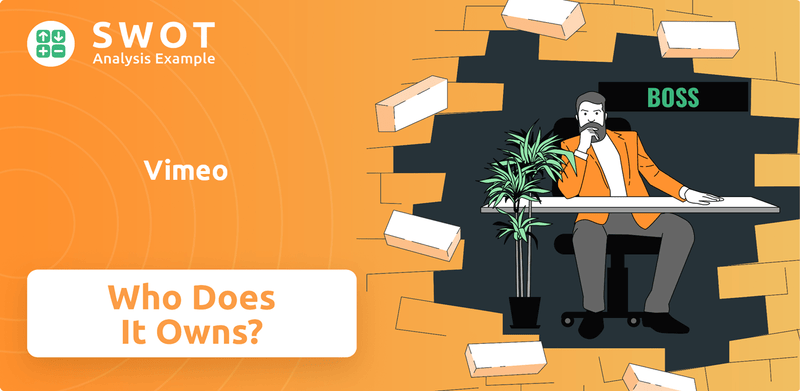
From its inception, Vimeo has carved a niche in the competitive video-sharing landscape. This analysis explores the Vimeo SWOT Analysis, delving into the significant shifts in ownership, from its founders to the major shareholders influencing its trajectory today. Discover the answers to questions like "Who owns Vimeo" and "Who is the current CEO of Vimeo," to gain a comprehensive understanding of this dynamic company. The exploration also touches upon Vimeo's history and its market capitalization.
Who Founded Vimeo?
The story of Vimeo ownership begins in November 2004, conceived by Jake Lodwick and Zach Klein. They envisioned it as a 'skunkworks project' within Connected Ventures, the parent company of CollegeHumor. Lodwick is credited with coining the name 'Vimeo,' blending 'video' and 'me,' also an anagram for 'movie.'
Initially, the platform was designed for sharing and tagging short videos among friends, inspired by photo-sharing sites like Flickr. While the exact equity split at the start isn't publicly detailed, Vimeo operated independently during its early phase. The focus was on building a platform for creators to share videos, emphasizing quality and creativity.
In August 2006, IAC (InterActiveCorp) acquired a 51% controlling stake in Connected Ventures for $21 million, effectively taking majority Vimeo owner. This move was largely driven by the success of CollegeHumor, which was attracting around 6 million visitors monthly. Following Google's acquisition of YouTube in October 2006, IAC recognized Vimeo's potential and invested more resources into its development.
The early years of Vimeo's history saw significant shifts in ownership and strategic direction. Key points include:
- Founding: Vimeo was founded in November 2004 by Jake Lodwick and Zach Klein.
- Initial Focus: The platform started as a way to share and tag short videos among friends.
- IAC Acquisition: In August 2006, IAC acquired a 51% stake in Connected Ventures, becoming the majority owner. This was a pivotal moment in the evolution of the platform.
- Post-Acquisition Development: Following the acquisition, IAC increased investment in Vimeo, recognizing its potential in the video-sharing market.
- Departure of Co-founder: Jake Lodwick, one of the original founders, left the company in November 2007.
Vimeo SWOT Analysis
- Complete SWOT Breakdown
- Fully Customizable
- Editable in Excel & Word
- Professional Formatting
- Investor-Ready Format
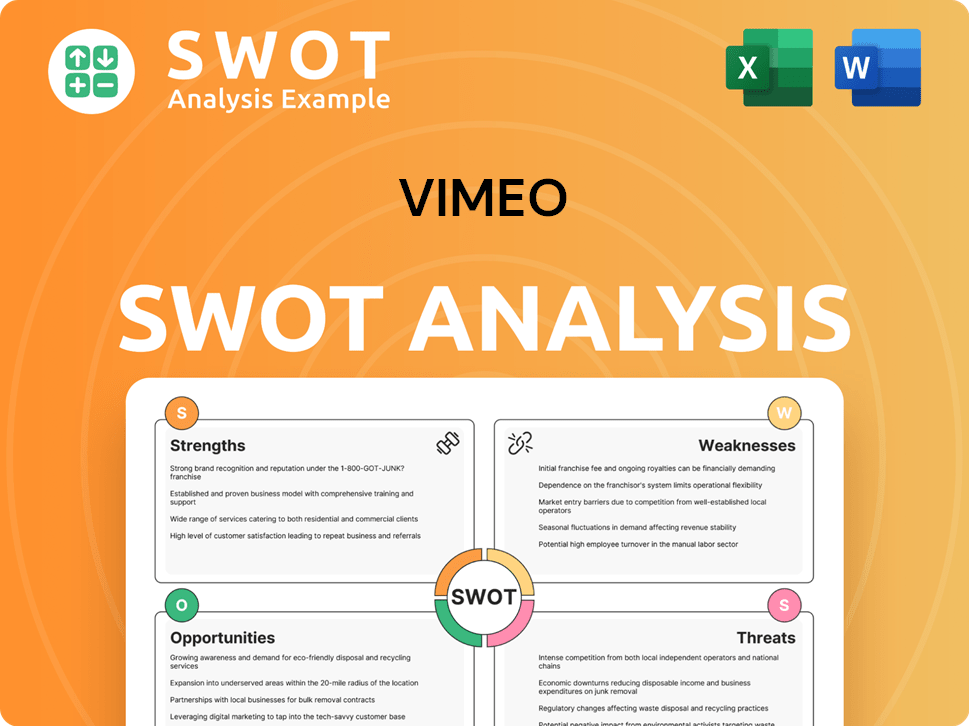
How Has Vimeo’s Ownership Changed Over Time?
The evolution of Vimeo ownership reflects its journey from a subsidiary to an independent, publicly traded company. Initially, from 2006 to 2013, it operated under IAC. This period saw Vimeo grow its user base. The year 2013 marked a significant shift when Vimeo was spun off, allowing it to operate independently. This led to its direct listing on Nasdaq on May 25, 2021, under the ticker 'VMEO,' solidifying its status as a public company.
The current Vimeo owner structure is primarily institutional. The shift to independence and public trading has reshaped its ownership landscape, with institutional investors holding a significant portion of the shares. This change highlights the company's growth and its integration into the broader financial market.
| Timeline | Event | Impact on Ownership |
|---|---|---|
| 2006-2013 | Operation under IAC | Subsidiary of IAC, focused on platform development. |
| 2013 | Spin-off from IAC | Became an independent company, fostering innovation. |
| May 25, 2021 | Direct listing on Nasdaq | Became a publicly traded company, attracting institutional investors. |
As of May and June 2025, institutional investors hold between 75.51% to 86.34% of the company's stock. Key shareholders include Vanguard Group Inc., holding 10.57%, and BlackRock Inc., with 7.90%. Insider ownership is approximately 3.68% to 11.90%. Public companies and individual investors hold roughly 1.76% to 20.81% of the stock. Barry Diller and Joseph Levin, through shares of capital stock and Class B common stock, significantly influence strategic decisions. You can learn more about the Marketing Strategy of Vimeo.
Vimeo's ownership has evolved from being a subsidiary to an independent, publicly traded company. Institutional investors now hold the majority of the shares, indicating strong market confidence.
- Vanguard Group Inc. and BlackRock Inc. are among the major institutional shareholders.
- Insider ownership, including executives, also plays a role in the company's governance.
- The concentration of voting power with key figures influences strategic decisions.
Vimeo PESTLE Analysis
- Covers All 6 PESTLE Categories
- No Research Needed – Save Hours of Work
- Built by Experts, Trusted by Consultants
- Instant Download, Ready to Use
- 100% Editable, Fully Customizable
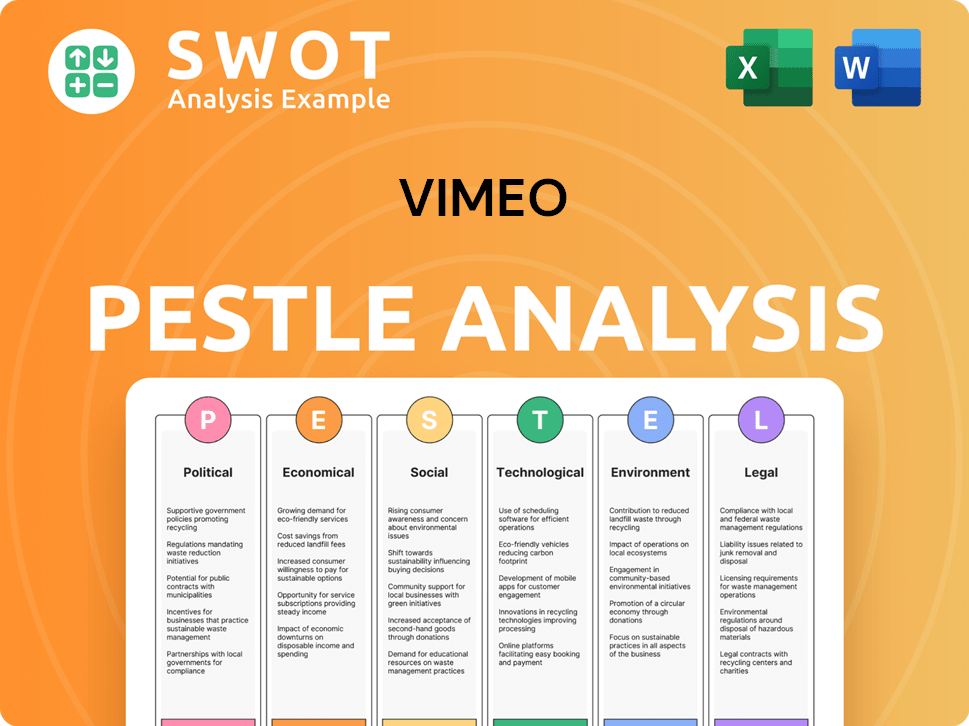
Who Sits on Vimeo’s Board?
As of the 2025 Annual General Meeting, the Board of Directors of Vimeo included nine director nominees. These individuals are: Adam Cahan, Adam Gross, Jay Heratti, Lydia Jet, Kirsten Cliffhouse, Mo Homan, Glenn Schiffman, Alexander von Furstenberg, and Philip Moyer. Philip Moyer currently serves as the CEO of Vimeo.
Alexander von Furstenberg represents a significant shareholder, and his holdings, combined with those of Barry Diller, represent a substantial portion of the voting power within the company. This structure allows these major shareholders to significantly influence the company's direction.
| Director | Title | Additional Information |
|---|---|---|
| Philip Moyer | CEO | Current CEO of Vimeo |
| Alexander von Furstenberg | Director | Represents major shareholder |
| Adam Cahan | Director |
Vimeo operates under a dual-class common stock structure. This structure gives specific shareholders more voting power. Class B common stock gets ten votes per share, while common stock holders get one vote per share. As of December 31, 2024, Barry Diller and Alexander von Furstenberg controlled approximately 38% of the total voting power. Joseph Levin, the Chairman of Vimeo's Board and CEO of IAC, held approximately 2% of the total voting power as of December 31, 2024. This concentrated power allows them to significantly influence the Board of Directors and other key decisions. Understanding the Competitors Landscape of Vimeo is also important to understand its market position.
Vimeo's dual-class structure concentrates voting power, allowing significant influence by key shareholders. This structure impacts the election of directors and other stockholder actions.
- Class B shares have ten votes each.
- Barry Diller and Alexander von Furstenberg held approximately 38% of the total voting power as of December 31, 2024.
- Joseph Levin held approximately 2% of the total voting power as of December 31, 2024.
- Director elections and stockholder actions are affected by this structure.
Vimeo Business Model Canvas
- Complete 9-Block Business Model Canvas
- Effortlessly Communicate Your Business Strategy
- Investor-Ready BMC Format
- 100% Editable and Customizable
- Clear and Structured Layout
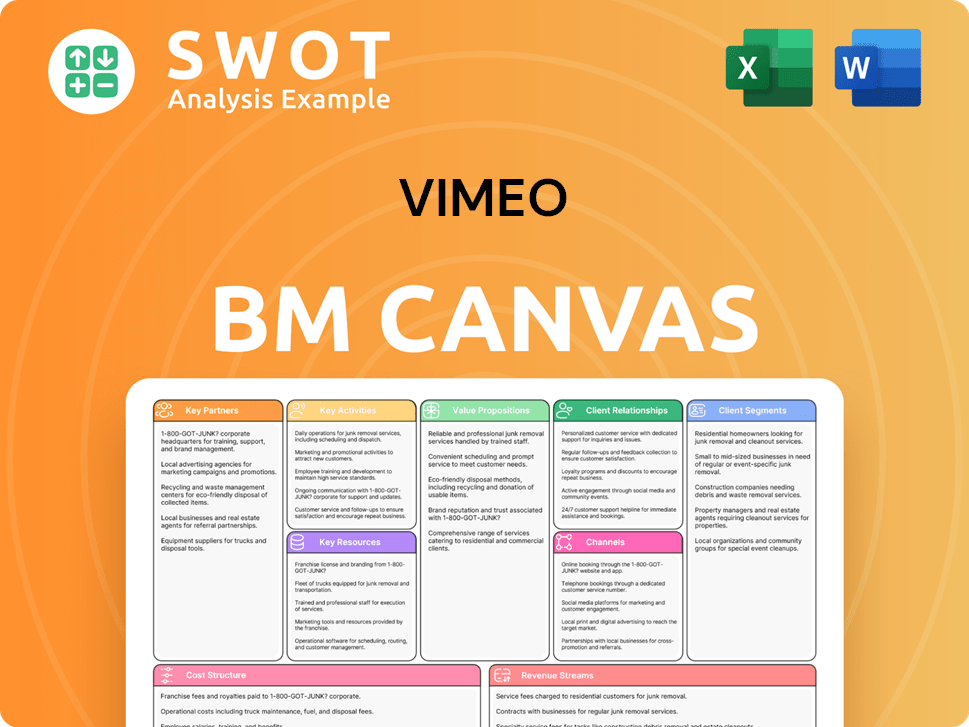
What Recent Changes Have Shaped Vimeo’s Ownership Landscape?
Over the past few years, significant changes have occurred in the ownership structure and strategic direction of Vimeo. The company, which became independent in May 2021 after its spin-off from IAC, has been actively managing its capital. This includes share repurchase programs, with 5.9 million shares repurchased in 2024 for $26.8 million. Furthermore, as of February 13, 2025, an additional 1.5 million shares were bought back for $9.7 million, leaving $13.7 million available under the share repurchase authorization. In Q1 2025, Vimeo repurchased 3.9 million shares, exhausting its existing $50 million share repurchase authorization. On April 29, 2025, the Board authorized a new stock repurchase program of up to $50 million.
Institutional ownership remains a key aspect of Vimeo's profile. As of February 2025, institutional investors held 91.13% of the company, decreasing to 86.34% by May 2025. In Q4 2024, there was notable activity among institutional investors, with some increasing and others decreasing their positions. For example, Thrive Capital Management, LLC, added 5,852,853 shares. Conversely, T. Rowe Price Investment Management, Inc. and Divisar Capital Management LLC reduced their holdings. Mutual funds increased their holdings from 52.87% to 53.10% in May 2025. Insider ownership stood at 5.7% as of February 2025.
| Metric | Details | Date |
|---|---|---|
| Share Repurchases | 5.9 million shares for $26.8 million | 2024 |
| Institutional Ownership | 91.13% | February 2025 |
| Cash and Cash Equivalents | $289 million | Q1 2025 |
Vimeo is also focusing on strategic investments, particularly in AI, enterprise solutions, and new video formats. The company plans to invest up to an additional $30 million in 2025, above 2024 levels. This strategic direction aims for low single-digit revenue growth in 2025, with an acceleration to double-digit growth by the end of the year. Despite a net loss of $0.02 per share in Q1 2025, Vimeo achieved its third consecutive quarter of year-over-year bookings growth. To learn more about the users of Vimeo, read this article about the Target Market of Vimeo.
Vimeo is a publicly traded company. The majority of the company is owned by institutional investors.
As of May 2025, institutional investors hold a significant portion of the company's shares, with 86.34% ownership.
Vimeo's financial backers include various institutional investors, with some increasing and decreasing their holdings.
Major shareholders include institutional investors. Thrive Capital Management, LLC, is a notable investor.
Vimeo Porter's Five Forces Analysis
- Covers All 5 Competitive Forces in Detail
- Structured for Consultants, Students, and Founders
- 100% Editable in Microsoft Word & Excel
- Instant Digital Download – Use Immediately
- Compatible with Mac & PC – Fully Unlocked
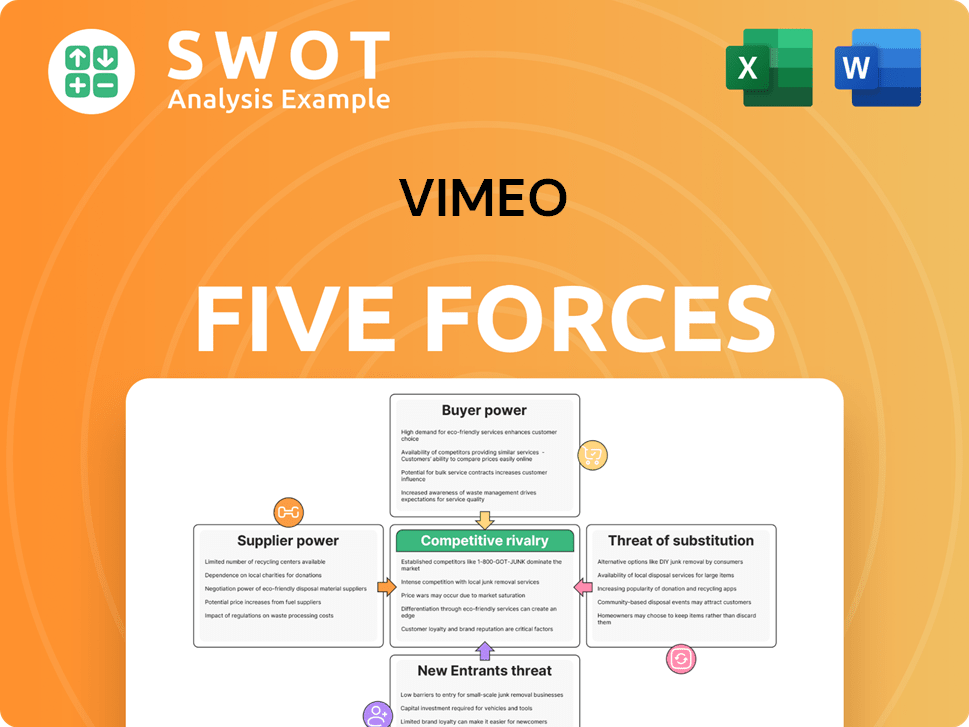
Related Blogs
- What are Mission Vision & Core Values of Vimeo Company?
- What is Competitive Landscape of Vimeo Company?
- What is Growth Strategy and Future Prospects of Vimeo Company?
- How Does Vimeo Company Work?
- What is Sales and Marketing Strategy of Vimeo Company?
- What is Brief History of Vimeo Company?
- What is Customer Demographics and Target Market of Vimeo Company?
Disclaimer
All information, articles, and product details provided on this website are for general informational and educational purposes only. We do not claim any ownership over, nor do we intend to infringe upon, any trademarks, copyrights, logos, brand names, or other intellectual property mentioned or depicted on this site. Such intellectual property remains the property of its respective owners, and any references here are made solely for identification or informational purposes, without implying any affiliation, endorsement, or partnership.
We make no representations or warranties, express or implied, regarding the accuracy, completeness, or suitability of any content or products presented. Nothing on this website should be construed as legal, tax, investment, financial, medical, or other professional advice. In addition, no part of this site—including articles or product references—constitutes a solicitation, recommendation, endorsement, advertisement, or offer to buy or sell any securities, franchises, or other financial instruments, particularly in jurisdictions where such activity would be unlawful.
All content is of a general nature and may not address the specific circumstances of any individual or entity. It is not a substitute for professional advice or services. Any actions you take based on the information provided here are strictly at your own risk. You accept full responsibility for any decisions or outcomes arising from your use of this website and agree to release us from any liability in connection with your use of, or reliance upon, the content or products found herein.